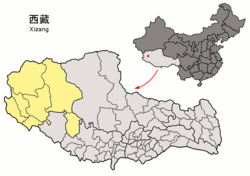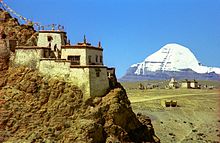Ngari Prefecture (Tibetan: མངའ་རིས་ས་ཁུལ་, Wylie: mnga' ris sa khul, ZYPY: ngari sakü) or Ali Prefecture (simplified Chinese: 阿里地区; traditional Chinese: 阿里地區; pinyin: Ālǐ Dìqū) is a prefecture of China's Tibet Autonomous Region covering Western Tibet, whose traditional name is Ngari Khorsum. Its administrative centre and largest settlement is the town of Shiquanhe. It is one of the least densely populated areas in the world, with 0.3 people per kilometer (0.85 per mile).[citation needed]
Ngari Prefecture 阿里地区 · མངའ་རིས་ས་ཁུལ། Ali Prefecture | |
|---|---|
 Lake Manasarovar and Mount Naimona'nyi | |
 Location of Ngari Prefecture within China | |
| Country | People's Republic of China |
| Autonomous region | Tibet |
| Prefecture seat | Gar County (Shiquanhe) |
| Area | |
| • Total | 304,683 km2 (117,639 sq mi) |
| Population | |
| • Total | 95,465 |
| • Density | 0.31/km2 (0.81/sq mi) |
| GDP | |
| • Total | CN¥ 3.7 billion US$ 0.6 billion |
| • Per capita | CN¥ 36,378 US$ 5,841 |
| Time zone | UTC+8 (China Standard) |
| ISO 3166 code | CN-XJ-25 |
| Website | Ngari(Ali) Prefecture Government |
History

Ngari was once the heart of the ancient kingdom of Guge. Later Ngari, along with Ü and Tsang, composed Ü-Tsang, one of the traditional provinces of Tibet, the others being Amdo and Kham.
The prefecture has close cultural links with Kinnaur and Lahaul and Spiti district of the bordering Indian state of Himachal Pradesh.[1]
Geography and climate
The paved Xinjiang-Tibet Highway (新藏公路) passes through this area. There are well-known prehistoric petroglyphs near the far western town of Rutog.
The town of Ngari lies 4,500 metres (14,800 ft) above sea level in northwest Tibet some 1,600 kilometres (990 mi) west of the capital, Lhasa. Ali Kunsha Airport began operations on July 1, 2010, becoming the fourth civil airport in Tibet (shortening the trip to Lhasa to one-and-a-half hours from three or four days by car) along with Lhasa Gonggar Airport in Lhasa, Qamdo Bamda Airport in Chamdo and Nyingchi Mainling Airport.[2]
Ngari is best known for Mount Kailash, also called Sumeru, and Lake Manasarovar. Mount Kailash is 6,714 m (22,028 ft) above sea level and is the main peak of the Transhimalaya (also called the Kailash Range or Gangdisê Mountains). The holy mountain and lake are associated with number of religions: Buddhism, Hinduism, and Bon, among others, attracting numerous domestic and international religious pilgrims and tourists. Surrounding Mount Kailash are four ancient and famous monasteries: Zhabura, Chiu Gompa, Zheri and Zhozhub. Manasarovar lies 4,588 m (15,052 ft) above sea level, covers an area of 412 km2 (159 sq mi) and reaches a maximum depth of 70 m (230 ft).
Ngari has a cold desert climate (Köppen climate classification: BWk), with strong dry-winter subarctic climate tendencies (Köppen climate classification: Dwc).
| Climate data for Shiquanhe (1991–2020 normals) | |||||||||||||
|---|---|---|---|---|---|---|---|---|---|---|---|---|---|
| Month | Jan | Feb | Mar | Apr | May | Jun | Jul | Aug | Sep | Oct | Nov | Dec | Year |
| Record high °C (°F) | 6.4 (43.5) | 9.5 (49.1) | 14.5 (58.1) | 15.7 (60.3) | 20.5 (68.9) | 25.2 (77.4) | 32.1 (89.8) | 26.4 (79.5) | 23.7 (74.7) | 16.7 (62.1) | 12.7 (54.9) | 7.1 (44.8) | 32.1 (89.8) |
| Mean daily maximum °C (°F) | −4.0 (24.8) | −1.8 (28.8) | 2.7 (36.9) | 8.1 (46.6) | 13.0 (55.4) | 18.5 (65.3) | 22.0 (71.6) | 20.8 (69.4) | 16.8 (62.2) | 8.8 (47.8) | 3.6 (38.5) | −0.6 (30.9) | 9.0 (48.2) |
| Daily mean °C (°F) | −11.7 (10.9) | −9.0 (15.8) | −4.4 (24.1) | 0.9 (33.6) | 5.7 (42.3) | 11.3 (52.3) | 15.0 (59.0) | 14.2 (57.6) | 9.9 (49.8) | 1.3 (34.3) | −4.7 (23.5) | −9.0 (15.8) | 1.6 (34.9) |
| Mean daily minimum °C (°F) | −19.3 (−2.7) | −16.6 (2.1) | −12.3 (9.9) | −7.0 (19.4) | −2.0 (28.4) | 4.1 (39.4) | 8.5 (47.3) | 8.1 (46.6) | 2.8 (37.0) | −7.0 (19.4) | −13.0 (8.6) | −17.1 (1.2) | −5.9 (21.4) |
| Record low °C (°F) | −36.6 (−33.9) | −30.2 (−22.4) | −25.3 (−13.5) | −17.9 (−0.2) | −11.2 (11.8) | −6.6 (20.1) | −0.6 (30.9) | −0.4 (31.3) | −10.0 (14.0) | −17.0 (1.4) | −23.5 (−10.3) | −32.9 (−27.2) | −36.6 (−33.9) |
| Average precipitation mm (inches) | 1.6 (0.06) | 1.7 (0.07) | 1.1 (0.04) | 1.3 (0.05) | 2.9 (0.11) | 5.8 (0.23) | 22.9 (0.90) | 25.3 (1.00) | 5.5 (0.22) | 1.7 (0.07) | 0.2 (0.01) | 0.6 (0.02) | 70.6 (2.78) |
| Average precipitation days (≥ 0.1 mm) | 1.8 | 2.0 | 1.3 | 0.9 | 2.0 | 2.8 | 7.0 | 8.7 | 3.1 | 0.7 | 0.4 | 0.6 | 31.3 |
| Average snowy days | 3.9 | 4.3 | 3.6 | 3.5 | 4.8 | 2.1 | 0.1 | 0.3 | 1.0 | 1.4 | 1.0 | 1.6 | 27.6 |
| Average relative humidity (%) | 34 | 33 | 29 | 27 | 28 | 30 | 37 | 42 | 34 | 24 | 24 | 26 | 31 |
| Mean monthly sunshine hours | 250.1 | 241.3 | 299.1 | 304.9 | 332.8 | 333.6 | 309.9 | 289.9 | 299.7 | 311.1 | 274.7 | 262.6 | 3,509.7 |
| Percent possible sunshine | 78 | 77 | 80 | 78 | 77 | 78 | 72 | 71 | 82 | 90 | 88 | 85 | 80 |
| Source: China Meteorological Administration[3][4][5] | |||||||||||||
Subdivisions
Ngari Prefecture is subdivided into seven county-level divisions: seven counties.
| # | Name | Chinese (S) | Hanyu Pinyin | Tibetan | Wylie | Tibetan pinyin | Population (2010 Census) | Area (km2) | Density (/km2) | |||
|---|---|---|---|---|---|---|---|---|---|---|---|---|
| 1 | Gar County | 噶尔县 | Gá'ěr Xiàn | སྒར་རྫོང་། | sgar rdzong | Gar Zong | 16,901 | 13,179 | 1.28 | |||
| 2 | Burang County | 普兰县 | Pǔlán Xiàn | སྤུ་ཧྲེང་རྫོང་། | spu hreng rdzong | Burang Zong | 9,657 | 24,602 | 0.39 | |||
| 3 | Zanda County | 札达县 | Zhádá Xiàn | རྩ་མདའ་རྫོང་། | rtsa mda' rdzong | Zanda Zong | 6,883 | 18,083 | 0.38 | |||
| 4 | Rutog County | 日土县 | Rìtǔ Xiàn | རུ་ཐོག་རྫོང་། | ru thog rdzong | Rutog Zong | 9,738 | 77,096 | 0.12 | |||
| 5 | Gê'gyai County | 革吉县 | Géjí Xiàn | དགེ་རྒྱས་རྫོང་། | dge rgyas rdzong | Gê'gyai Zong | 15,483 | 46,117 | 0.33 | |||
| 6 | Gêrzê County | 改则县 | Gǎizé Xiàn | སྒེར་རྩེ་རྫོང་། | sger rtse rdzong | Gêrzê Zong | 22,177 | 135,025 | 0.16 | |||
| 7 | Coqên County | 措勤县 | Cuòqín Xiàn | མཚོ་ཆེན་རྫོང་། | mtsho chen rdzong | Coqên Zong | 14,626 | 22,980 | 0.63 | |||
See also
Footnotes
Further reading
- Bellezza, John Vincent: Zhang Zhung. Foundations of Civilization in Tibet. A Historical and Ethnoarchaeological Study of the Monuments, Rock Art, Texts, and Oral Tradition of the Ancient Tibetan Upland. Denkschriften der phil.-hist. Klasse 368. Beitraege zur Kultur- und Geistesgeschichte Asiens 61, Verlag der Oesterreichischen Akademie der Wissenschaften, Wien 2008.
- Ngari Prefecture Annals Editing Office (《阿里地区志》编辑室). 2009. Ngari Prefecture Annals. (in Chinese) (English language Table of Contents: pp. 1585-1600)
- Zeisler, Bettina. (2010). "East of the Moon and West of the Sun? Approaches to a Land with Many Names, North of Ancient India and South of Khotan." In: The Tibet Journal, Special issue. Autumn 2009 vol XXXIV n. 3-Summer 2010 vol XXXV n. 2. "The Earth Ox Papers", edited by Roberto Vitali, pp. 371–463.
External links
- Ngari
- Ngari (Tibet Online)
- 西藏阿里 ('Ngari, Tibet') (2002) (in Chinese)
